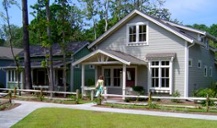New Training Required for ENERGY STAR Partners

 The ENERGY STAR homes program has grown tremendously since it was introduced in the mid 1990s. In the initial program, version 1 of the guidelines, most homes were certified through a home energy rating and a single inspection that occurred when the house was finished. Version 2, introduced in 2006, required 2 inspections, one at the predrywall stage and one at final, as well as the completion of the Thermal Bypass Checklist.
The ENERGY STAR homes program has grown tremendously since it was introduced in the mid 1990s. In the initial program, version 1 of the guidelines, most homes were certified through a home energy rating and a single inspection that occurred when the house was finished. Version 2, introduced in 2006, required 2 inspections, one at the predrywall stage and one at final, as well as the completion of the Thermal Bypass Checklist.
The ENERGY STAR homes program has grown tremendously since it was introduced in the mid 1990s. In the initial program, version 1 of the guidelines, most homes were certified through a home energy rating and a single inspection that occurred when the house was finished. Version 2, introduced in 2006, required 2 inspections, one at the predrywall stage and one at final, as well as the completion of the Thermal Bypass Checklist.
ENERGY STAR version 3 is now out but doesn’t become mandatory until 2012. It still requires 2 inspections, but the number of checklists has increased to 4. The version 3 guidelines are quite a bit more stringent than version 2. As I wrote in my earlier article (linked above), the stringency is ENERGY STAR’s attempt to stay ahead of the ever increasing code requirements and to make the program really meaningful. Sam Rashkin, the head of the program, is a man on a mission.
If you’ve had anything to do with version 2 of the program – as a HERS rater, builder, or HERS provider – you understand the frustration in the process of qualifying homes for the ENERGY STAR label. Some of the requirements (e.g., Manual J and the limit to oversizing of cooling systems) have been difficult to enforce. Part of this is because of unwillingness of builders and trade contractors to change, but lack of understanding also plays a role. HVAC is usually the most difficult part, which is why Energy Vanguard is offering special classes in HVAC for raters now.
The ENERGY STAR program administrators have decided to go after that lack of understanding by introducing a new training for its ENERGY STAR Partners. I first heard about this at the RESNET conference in February, when Zak Shadid announced their training intentions to the Training & Education Committee. The announcement of the train-the-trainer sessions showed up in my email yesterday, so the program moves forward.
have decided to go after that lack of understanding by introducing a new training for its ENERGY STAR Partners. I first heard about this at the RESNET conference in February, when Zak Shadid announced their training intentions to the Training & Education Committee. The announcement of the train-the-trainer sessions showed up in my email yesterday, so the program moves forward.
The intention of the new training class, which will be available to HERS raters only through RESNET accredited HERS training providers, is to make sure that raters understand the new requirements in version 3. This new training class will be required for all ENERGY STAR rater partners as well as HERS providers and must be completed before 2012 to continue qualifying new homes for the ENERGY STAR label. Look for HERS training providers to start offering the class as early as November. The class will count towards RESNET’s continuing education requirements for raters.
I know some HERS raters feel gouged by all the training and certification requirements of all the programs (ENERGY STAR, LEED for Homes, NAHB, EarthCraft House…) and will not take this well. In this economy, it’s certainly a challenge to make everything work sometimes, and I face those same issues. The ENERGY STAR homes program, however, is the foundation for this whole industry.
The new training requirement is a good thing. As a whole, I think many home energy raters are undertrained, especially when they’re newly certified. A 5 or 6 day HERS rater class is, in my opinion, woefully inadequate preparation. (More on that later!)
Download our 16 page white paper by clicking the link below:
Getting Ready for Version 3 (and 2.5) of the ENERGY STAR Homes Program
.
This Post Has 4 Comments
Comments are closed.

The move from 2.0 to 3.0 is
The move from 2.0 to 3.0 is also consistent with the overall definition of Energy Star Rated Items. They represent the best 20% of what is being built. Because technology improves and builders build better, because competition causes builders to build better, because the American ethic of ‘build a better mousetrap’ is at work; we have a situation that causes all products, including houses to meet periodically increased standards for Energy Star Certification.
I’m a real estate appraiser
I’m a real estate appraiser and also certified home inspector in the Seattle area. I recently took a built green class for appraisers. I’m interested in finding out about becoming an Energy Star rater. I would like to know who hires them, what businesses I might contact in my area, what kind of income can a rater expect, and what is involved in initial investment and training.
Roy, I don’t know if they’ve
Roy, I don’t know if they’ve gotten accredited as a HERS training provider yet, but Kyle Chase of Energy Conservation Training Co. in Portland, Oregon would be a good contact for you and might be your closest HERS trainer.
I think the best sources of answers for your general questions about becoming a HERS rater are the RESNET/BPI group on LinkedIn and Home Energy Pros. There’s already been a lot of discussion about that topic in both places, and you can always start a new one, too.
One thing I recommend if you’re serious about this is to study as much as you can before you take a class. Buy a copy of Residential Energy and read it. Subscribe to our blog. Download a trial copy of REM/Rate and learn how to use it. Learn as much as you can. I wrote a little article here about my top 5 sources of building science info, too.
Oops. Here’s the link for
Oops. Here’s the link for that top 6 sources of building science info article, Roy.